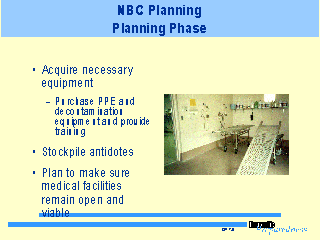|
|
|
|
front |1 |2 |3 |4 |5 |6 |7 |8 |9 |10 |11 |12 |13 |14 |15 |16 |17 |18 |19 |20 |21 |22 |review |
 |
- Purchase PPE and decontamination equipment and train frequently utilizing this equipment to protect the safety of the hospital provider. All training and materials used must conform to OSHA standards and regulations. Routine protective gear (such as goggles, surgical facemask, gloves, and gown) may not offer sufficient protection in all circumstances (that is, nerve agent attack). Levels of PPE will be determined by the local jurisdiction. - Develop adequate caches of antidotes that are readily available to quickly and accurately treat victims of a chemical attack. EDs should maintain basic treatment guidelines for the types of NBC events likely to be seen. Summarizing this information on treatment cards or posters helps to regularly reinforce the information while streamlining the delivery of medical care. - Develop a plan to ensure security of the hospital during a terrorist or disaster event. Emergency backup phone and communication systems need to be in place. Identifying alternative sites for providing medical care to patients with minor problems will help ensure continual access to healthcare. |